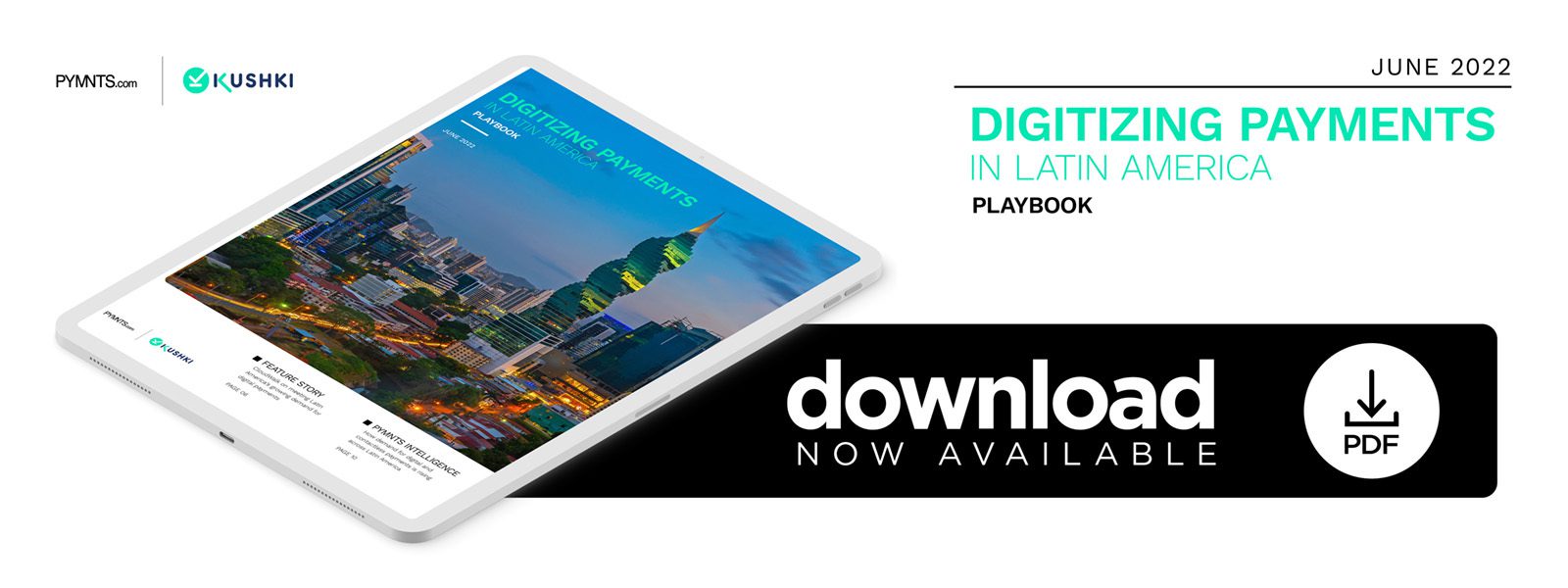PYMNTS Intelligence: How Demand for Digital and Contactless Payments Is Growing Across Latin America

 The pandemic accelerated the digitization of companies’ customer interactions by as much as four years and the share of their digital product offerings by an astounding seven years. As companies across the globe worked double-time to develop digital- and mobile-first platforms to adapt to pandemic-related restrictions, consumers readily shifted their primary payment methods toward digital technologies. The result is that cashless transactions are projected to double globally by 2030, with the Asia-Pacific region showing the biggest appetite for contactless, digital payments.
The pandemic accelerated the digitization of companies’ customer interactions by as much as four years and the share of their digital product offerings by an astounding seven years. As companies across the globe worked double-time to develop digital- and mobile-first platforms to adapt to pandemic-related restrictions, consumers readily shifted their primary payment methods toward digital technologies. The result is that cashless transactions are projected to double globally by 2030, with the Asia-Pacific region showing the biggest appetite for contactless, digital payments.
Despite widespread payment changes and restrictions on cash usage in the midst of the pandemic, Latin American countries were hesitant to embrace digital payments with open arms. Reports on digital adoption in Brazil during the crisis, for example, showed around one-quarter of banked citizens still avoided mobile payments due to concerns about their safety or uncertainty around how the process works.
Brazil was not unique in the region in its trepidation toward the digital shift. In Mexico, for example, while debit cards are used for online purchases 88% of the time, cash payments upon delivery are still a close contender at 74% — a gap that feels too narrow for promoters of digital transformation. The rivalry between cash and digital has been Latin America’s key obstacle in the quest to become a digital-first economy. Adding to the region’s traditional cash dependence are unbanked and underbanked citizens, who present an impediment to increased digital adoption.
Increasing the awareness and accessibility of digital payment methods in Latin America is a code that remains to be fully cracked. This month, PYMNTS Intelligence examines how leaders in the FinTech industry, government and legacy financial institutions (FIs) across the region are seeking to decrease cash dependency to stimulate economic growth, keep pace with an increasingly digitized world and promote greater financial inclusion for Latin American citizens.
Convenience, Access and Education Are Key to Adoption
While major strides still need to be made to promote financial inclusivity in Latin America, early research shows that for those citizens who are banked, digital transactions are slowly becoming the new norm. Citizens who began using innovative payment technology in the wake of the pandemic have become more accustomed to these safer, quicker and more convenient payment methods, offering proof that, with thoughtful implementation, next-generation payments can become more prevalent.
The earliest indicator of Latin America’s ability to adapt to online payment tools comes by way of eCommerce, which is expected to grow in the region at a compound annual growth rate of 19% through 2025. Argentina’s eCommerce market is expected to show the largest global year-over-year growth, with experts estimating 26% gains through 2025, thanks in part to Argentinians’ willingness to download new apps.
While credit cards are currently the most commonly used payment method for eCommerce transactions across all of Latin America, research indicates that digital wallet usage will surpass credit and debit card usage in Mexico by 2024. Digital wallet adoption is taking off across many types of vendors, from global brands such as PayPal and Apple Pay to regional and local options including RappiPay, Mercado Pago and Yape. Digital wallets made up 19% of Latin American eCommerce spend in 2021, compared to credit cards’ 39%.
Trending Toward Digital Adoption
As the routine of leveraging digital payments becomes more ingrained in consumer habits and as more merchants implement the technology to allow for contactless payments — specifically with in-store, face-to-face transactions — signs indicate that Latin America is picking up the pace with the digital transformation. In fact, Visa recently released a study showing that eight countries in Latin America and the Caribbean are already extensively using digital payment methods, with contactless technology accounting for more than half of face-to-face transactions.
Though the pace of adoption is favorable, FIs, private and public companies and government entities must still work together to improve payment diversification, financial inclusion and awareness. This includes building interoperability into payment systems for even more convenience. Take, for example, the Transfers 3.0 system in Argentina, which launched in 2021. The program is designed to leverage QR codes that connect to all virtual wallets, whether from a bank or a FinTech, and could be accepted by any business, regardless of the organization providing the code. This advanced connectivity and versatility in payment methods has proven successful, as Argentina now has the third highest-ranking volume of online purchases in Latin America. Another example is Mexico’s newly launched interoperable system for mobile QR code payments, which works similarly to allow businesses to connect with digital wallets and enable consumer payments through QR codes.
By pairing innovative technologies and increased convenience, the hope is that cash dependency will drop and the appetite for digital payments will continue to grow, benefiting all.
